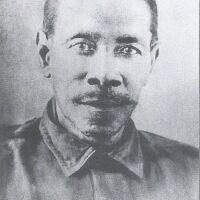In celebration of Black History Month, we bring you a moment in Black History in Southwest Florida.
Nelson Tillis

In celebration of Black History Month, we bring you a moment in Southwest Florida Black History.
Nelson Tillis arrived in our area on Christmas Day 1867. He's recognized as one of the first African American settlers of Fort Myers. Tillis married Ellen Summerall, a white woman of British descent. When and where they met is unknown. The couple had 11 children.
As one-time neighbors to inventor Thomas Edison, the Tillis children were often seen playing on the grounds of the Edison home or learning how to fish with Mr. Edison.
Tillis traveled to Key West to hire a tutor for his children. On his property, he built a one-room schoolhouse, ultimately becoming the first school for black children in Fort Myers.
A man of many skills, Tillis made a living as a builder, farmer, commercial fisherman and fishing guide.
Lee County Black History Society

The Lee County Black History Society in Fort Myers represents the legacy of the African American experience in Lee County. It was founded in 1994 by Janice Cass.
The society is located in the Williams Academy Black History Museum at Roberto Clemente Park in Dunbar.
The historic building was an old schoolhouse built in 1912 to educate Black children in Lee County. It was slated to be demolished until community activists raised awareness and money to preserve the school. In 1995, it was relocated to where it sits today.
The museum showcases an interactive classroom, memorabilia of local Black residents, along with the history and culture of the Black community. The museum is open Wednesday through Friday, and Saturday by appointment only.
Sarasota Wade-Ins

For generations, less than 2 miles of Florida’s 825 miles of beaches were open for African Americans to enjoy because of Jim Crow laws.
In Sarasota, Black people were not allowed to enjoy their neighborhood beach. They had to travel miles away to the beaches designated for African Americans.
On October 2, 1955, around 100 African Americans from (historically black neighborhood) Newtown in Sarasota, caravanned to nearby Lido Beach and held a wade-in — just like the sit-ins during the civil rights movement.
Local NAACP president Neil Humphrey, Sr. organized the caravan and protest.
The local wade-ins became a regular weekly protest. Into the 1960s, Sarasota’s beaches remained segregated and the protests continued.
It took the Civil Rights Act of 1964 to do away with segregated beaches for good.
Today, in Southwest Florida Black History, we celebrate the beach wade-ins in Sarasota that ignited the integration of beaches in Florida.
Battle of Fort Myers and the Clayton Statue
You may have seen the large bronze statue in Fort Myers' Centennial Park overlooking the river.

The statue is named Clayton. It represents the 179,000 Black soldiers who served in the United States Colored Troops during the Civil War.
The historic statue also represents The Battle of Fort Myers, fought on February 20, 1865, during the last months of the American Civil War.
On that day, the U.S. Colored Troops 2nd Regiment Infantry repelled an attack by Confederates sent to destroy the military fort and (re) capture some 4,000 head of cattle. The Confederates withdrew, suffering about 40 casualties.
In 2000, the City of Fort Myers commissioned local sculptor D.J. Wilkins to create a tribute to African Americans who fought and died to protect Fort Myers. Thus Clayton was born.
Herbert Cambridge of Collier County

Herbert Cambridge was a devoted educator, a prominent local activist and a pioneer in Naples.
He was born in Old Town in Dixie County, near Gainesville in 1927.
He served in the U.S. Army Air Force in the Philippines at the tail end of World War II before earning a bachelor's degree at historically black Bethune-Cookman College in Daytona Beach.
Cambridge moved to Naples in 1959 to establish George Washington Carver High School...the only all-Black high school in Naples.
He was one of the first African American teachers in Collier County and the first Black teacher at Naples High School.
Some students gave him the nickname "Fess," short for professor.
Cambridge also served as the NAACP of Collier County president for more than a decade.
Herbert Cambridge Elementary School in Naples is named in his honor.
WGCU is your trusted source for news and information in Southwest Florida. We are a nonprofit public service, and your support is more critical than ever. Keep public media strong and donate now. Thank you.



